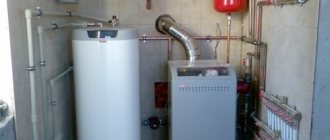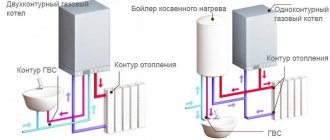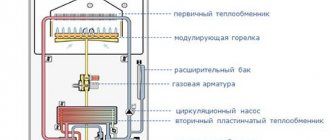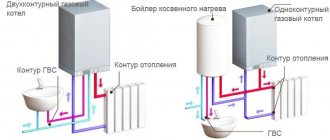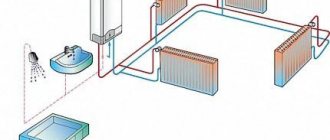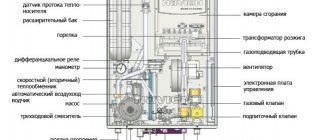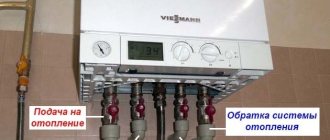Home |Useful articles |Double-circuit boiler in comparison with a single-circuit boiler and a gas water heater
Date: October 6, 2020
Comments: 1
In matters of water treatment in a private home, there is an eternal debate between universal and specialized approaches.
A universal view is to provide the home with heat and hot water using a double-circuit gas boiler that solves both problems simultaneously. The second option is specialization, when one unit (gas water heater) supplies hot water, and another (single-circuit boiler) handles home heating.
Specialists of the GradusPlus project, who have posted more than one material on their portal gradusplus.com about ways to save and optimize home heating, presented all the pros and cons of each of the schemes. They also determined why a single-circuit boiler and gas water heater are better and more comfortable, but not always.
Double-circuit gas boilers
Such boilers constructively separate the heating circuits of DHW and coolant, while sanitary water from the DHW circuit does not mix with technical water in the heating circuit. In our climate, they have two main operating modes:
- simultaneous maintenance of temperature in the hot water circuit and heating of the room in winter (or, if necessary, in cold summer);
- summer provision of hot water for household needs when heating is turned off (summer mode).
Operating modes can be controlled manually (for budget models) and automatically, depending on the situation outside the home (for advanced boilers). Double-circuit equipment is divided into two types: with a common or two separate heat exchangers.
Differences between boilers with one bithermal heat exchanger and two separate monothermal ones.
Is it possible to open cold water when the gas water heater is on?
In water heaters with a modulating burner, you can use hot and cold water
no limits.
When
the pressure in the pipeline decreases, the intensity of the flame will change.
Most modern speakers can easily withstand changes associated with the addition of cold water
.
Interesting materials:
Why is uterine tone dangerous in the second trimester? Why is tone dangerous? How is placental abruption dangerous for the fetus? Why is uterine fibroid dangerous? Why is granuloma dangerous? Why is a left kidney cyst dangerous? Why is a cyst on the left ovary dangerous? Why is a right kidney cyst dangerous? Why is a cyst in the maxillary sinus dangerous? Why is a dental cyst dangerous?
Boilers with double heat exchanger
This is the most compact and inexpensive design solution. The gas burner heats one heat exchanger, divided into two independent sectors for hot water and coolant. One circuit is inside the other. They are united only by the metal of the converter and do not mix in any way.
However, there are also significant disadvantages of the bithermal design. To increase efficiency, the sectors of the circuits are located very close and different-temperature fluid in them can strain and deform the entire structure. Corrosion in this system is also increased and requires high-quality water and coolant, otherwise the narrow channels will simply become overgrown with scale and become clogged.
How does an old gas water heater work?
Any geyser, even if it was made half a century ago, has safety devices in its design. Such devices include a water regulator, a flame sensor and a draft sensor. ... When the flame goes out, the plate cools down, straightens, and the valve shuts off the gas supply to the main burner.
Interesting materials:
Why does Birch bark burn so well? Why did Berlin become the capital of Germany? Why do wireless headphones turn off outdoors? Why does a sponge cake fall when baking? Why does the fern turn pale? Why do pancakes burn quickly? Why do they block in bla bla car? Why flea? Why are CSKA fans horses? Why are they no longer making 3D TVs?
Boilers with two separate heat exchangers
Heating and hot water circuits in such structures have their own, spaced-apart heat exchangers. The burner heats the heat exchanger of the heating circuit, and the DHW circuit is heated by contact with the heating circuit as soon as the tap is opened at the point of hot water consumption.
Advantages and disadvantages of using double-circuit gas boilers
| Advantages | Flaws |
| They save space at home, due to the fact that all units are located in one, all the same compact equipment | The main disadvantage is that if there is a malfunction, the building is deprived of heating and hot water supply at the same time |
| The total cost of two heaters combined in one housing is less than the purchase of 2 devices. And in general, a double-circuit gas boiler is the cheapest way to organize hot water supply | Hot water consumption points should be close to the boiler, i.e. in houses with an area of no more than 350-400 m2. When they are placed remotely and turned on at the same time, the water temperature drops sharply and heat losses increase. And the prepared water travels a long way, which leads to a large delay in supply. |
| Connecting from one gas pipe and using one chimney makes installation and obtaining permits easier and cheaper | The design of double-circuit gas boilers is more complex, especially if the heat exchangers are not separate. The combination of a single-circuit boiler and a gas water heater is, on average, always more reliable |
| The influence of water heating on the heating system in the summer is difficult to avoid |
Advantages and disadvantages of equipment
Both types of gas boilers are easy to operate, efficient and durable. They also have an attractive appearance.
The design of each type of gas boiler is designed to meet the needs of different categories of users, which clearly demonstrates their advantages and disadvantages. They also provide an opportunity to understand the differences between a single-circuit gas boiler and its double-circuit counterpart, helping the potential buyer make the right choice.
Pros and cons of single-circuit units
Such products are capable of providing stable heating of rooms of any size, number of floors, and distance from the heat exchanger.
And, in addition, single-circuit boilers:
- more reliable than their double-circuit counterparts, the design of which is more complex, which leads to a slightly larger number of breakdowns;
- easier to maintain , which is also caused by design features;
- cheaper.
An important advantage is that single-circuit units can become a base for connecting other equipment . This will expand their functionality and increase the comfort of living.
You should always remember that if you need to provide hot water supply in the premises, you will have to buy a storage boiler together with a single-circuit boiler. And this will lead to considerable additional costs. And a set of the listed equipment will take up a lot of space, which can be critical for small apartments
Connecting storage boilers will provide the premises with hot water supply. Moreover, the water will be supplied hot at any time, which is not always possible to achieve from dual-circuit analogues
This type of equipment, in the absence of the need for hot water supply, has no pronounced shortcomings. But otherwise, the lack of universality immediately affects. Which leads to the need to purchase an additional electric heating device.
As a result, its joint operation with a single-circuit boiler leads to:
- high costs for purchase, installation, maintenance;
- limited volume of water for domestic needs - boilers are most often purchased for joint use with single-circuit units, so the question may arise about the rational consumption of water, the volume of which depends on the capacity of the storage tank;
- greater load on the wiring.
The last drawback is relevant in cases where the house or apartment has old wiring or powerful electrical equipment is used in parallel. So, it may be necessary to modernize the electrical wiring and select a cable with a larger cross-section.
You should also be aware that a set of a single-circuit boiler and boiler takes up significantly more space than one double-circuit boiler. And with limited space this can be a significant disadvantage.
Advantages and disadvantages of double-circuit boilers
Units that belong to the specified type have some restrictions, but are still capable of providing hot water to two systems at once (heating, hot water supply). They also take up less space than their boiler counterparts. As a result, double-circuit boilers are more convenient to use.
Both types of gas boilers are easy to operate, efficient and durable. They also have an attractive appearance.
In addition, the competitive struggle of manufacturers has led to the fact that the difference in the cost of both types of units is gradually leveled out.
Therefore, today you can find a double-circuit boiler whose price is slightly higher than that of a single-circuit product. Which in some cases can also be considered an advantage.
If we talk about the disadvantages of double-circuit boilers, the most important is the inability to instantly provide hot water of the same temperature to all water consumption points in a house or apartment.
So, in their heat exchangers the amount of water that is needed right now is heated. That is, no stock is created. As a result, the water temperature may differ from what you expect or may change as you use it. This happens when the pressure or pressure changes, for example, after opening/closing the second tap.
When using a double-circuit boiler, the water temperature often differs at two different water intake points - hot water can be delivered to the desired point with a significant delay. Which is inconvenient and leads to additional costs
As for installation, installation of double-circuit boilers is a more complex procedure, especially at the design stage. Since you will have to follow numerous manufacturer’s recommendations
What is the difference between a system with a single-circuit boiler and a gas water heater?
Abandoning the universality of two heating circuits in favor of specialization leads to a significant simplification of the control system and an increase in its reliability.
This system allows:
- Autonomously heat a building using any coolant, regardless of hot water consumption.
- Heat the required amount of water while maintaining its temperature, regardless of distance from the boiler.
- Failure or shutdown of one of the systems as unnecessary does not entail consequences for the other circuit.
The disadvantages of this approach are already known:
- The total cost of installed equipment is significantly higher than with a universal scheme.
- The requirements of regulations SP 62.13330 (formerly SNiP 42-01-2002) complicate and make the project more expensive.
The rules for installing two gas appliances prohibit placing them on top of each other; equipment manufacturers indicate in the instructions the minimum distances between them. Regulation SP 62.13330 defines the minimum area of a room for joint installation of equipment up to 9 m2 and a ceiling height of more than 2.2 m, the gap under the door to the boiler room must be at least 5 cm. It is also worth noting the serious requirements for ventilation of the room.
Typical misleading photo. Above the floor-standing boiler there is a wall-mounted boiler, not a gas water heater. Subject to certain conditions, it is possible to install 2 boilers into one chimney, but not a gas water heater and a boiler.
The chimneys for both gas appliances must be separate; combining them completely violates the requirements of the regulations. Two gas connection points also make installation and obtaining permits more difficult and expensive.
Which equipment is better to choose?
When choosing a unit for heating a country house, cottage or apartment, consumers often find it difficult and cannot determine the model they need to purchase. Therefore, you need to at least briefly know the main characteristics and types of equipment.
Heating devices are represented by the following types:
- Single- and double-circuit units. The first ones are intended exclusively for hot water supply. The latter are equipped with 2 circuits, can heat the air in rooms and additionally provide water at the required temperature.
- With 1-2 heat exchangers. These are devices with bithermal, separate temperature sensors. The latter are durable and reliable due to their low sensitivity to water quality. When using bithermal models, anti-scale agents are required.
- Condensing units. Due to the high temperature of the exhaust gas, the equipment saves up to 16-18% of fuel when heating a house. The units are used when installing a “warm floor” system. The device achieves its highest efficiency at a temperature of about 40°C.
When purchasing heating equipment to heat your home, you need to focus on the planned load of the unit, the area of the premises, productivity and installation conditions. Additionally, other factors are taken into account, including the preferences and needs of the owners themselves.
If in doubt, it is better to consult a specialist, since replacing equipment will be costly and time-consuming.
Which is better: a double-circuit gas boiler or a single-circuit gas boiler?
Compliance with the regulations in an apartment in an apartment building does not provide the opportunity to choose between a double-circuit boiler and a boiler + boiler. There is usually no additional room for installing two gas units, even including the bathroom, since placing such equipment in it is legally prohibited.
It is possible to build a boiler room in a private house and it is quite possible to meet the requirements of SP 62.13330. The choice of method for organizing DHW depends on the budget and the availability of space in the boiler room.
If the budget is not so limited (at least from 50-55 thousand rubles for equipment and communications), and the premises allow you to meet the requirements described above, the choice is clear - a single-circuit boiler and a gas water heater. This scheme is more productive, reliable and practical/comfortable. Otherwise, a double-circuit gas boiler is quite justified; now their popularity has exceeded single-circuit models. The main thing is to approach the choice wisely, having studied all the criteria.
The further choice of equipment is determined by thermal engineering calculations: first to ensure the required temperature conditions, then to provide DHW. In practice, they often do not resort to complex calculations and use the norm: 1 kW per 10 m2 of area + 20-30% reserve.
Briefly about the main thing
In order to understand what is better - a single-circuit or double-circuit gas boiler, you must first find out how they are designed and what their pros and cons are.
The unit on the 1st circuit includes the following main components:
- Heat exchanger.
- Burner.
- Ignition system.
- Automation.
The 2-circuit analogue, in addition to this basic set, is equipped with a small heat exchanger for domestic hot water, a 3-way mechanism, a membrane tank, a safety group and a pump. In this case, a 1-circuit boiler initially works only for heating. In order to receive hot water from it, you need to connect an indirect heating boiler. 2-circuit models operate for both heating and hot water production.
However, when water is drawn, the supply of coolant to the radiators stops. In addition, both modifications have their own specific pros and cons. At the same time, the main differences between them are observed in hot water supply, dimensions, power and area of the room, equipment and space occupied by the equipment.
Differences in the design of single and double circuit units
What is the difference between the design of units with 1 circuit and with 2 circuits? If we talk about the main components, then the basic principle of operation is the same for both types of equipment:
- pipelines through which water is supplied from a well (water supply);
- expansion tank;
- smoke exhaust or coaxial pipe and burner.
One of the main things that distinguishes a single-circuit gas boiler from a 2-circuit one is the design of the heat exchanger.
If in a 1-circuit it is a pipe through which water is heated due to the exchange of heat from a gas burner, in a 2-circuit it is two double heat exchangers made of pipes and plates or one bithermal (to make it clearer, this is a pipe inside a pipe).
- primary, heating heating circuit;
- secondary or plate, responsible for heating the water.
Photo from https://teplowood.ru
However, the key difference is the 3-way valve, which is responsible for the direction of water. When the heating circuit heats up, the valve is in its normal position. However, when the DHW tap is opened, the device’s automation is activated due to the pressure difference. The valve blocks the access of hot water to the heating circuit. Then the coolant begins to circulate inside the boiler. At this moment the room is no longer heated.
Comparison table of characteristics and prices
| Model | Installation method | power, kWt | DHW capacity (35°C), l/min (boiler volume, l) | Cost, rub |
| Double-circuit gas | ||||
| Lemax Premium-20N(B) | Floor | 20 | 4,3 | 30 000 |
| Baxi SLIM 2.230i 4E | Floor | 22,1 | 9,3 | 110 000 |
| Baxi ECO-4s 24F | Wall | 24 | 9,8 | 36 000 |
| Buderus Logamax U072-12K | Wall | 12 | 6 | 28 000 |
| Single-circuit gas + boiler | ||||
| Lemax Premium-16 + Kospel SWR – 100 | Floor | 16 | 100 | 23 000 + 14 000 |
| Viessmann Vitopend 100-W A1HB001 + Drazice OKC 200 NTR | Wall | 24 | 208 | 42 000 + 26 000 |
| Baxi SLIM EF 1.31 + Baxi UBT 200 | Floor | 30,5 | 200 | 60 000 + 26 000 |
| De Dietrich DTG X 30 N + Drazice OKC 200 NTR | Floor | 30 | 208 | 88 000 + 26 000 |


